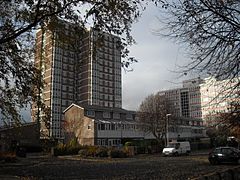Baguley facts for kids
Quick facts for kids Baguley |
|
|---|---|
 Baguley social housing. The tower-block is Brookway Court |
|
| Population | 14,794 (2011) |
| OS grid reference | SJ816891 |
| Metropolitan borough | |
| Metropolitan county | |
| Region | |
| Country | England |
| Sovereign state | United Kingdom |
| Post town | MANCHESTER |
| Postcode district | M23 |
| Dialling code | 0161 |
| Police | Greater Manchester |
| Fire | Greater Manchester |
| Ambulance | North West |
| EU Parliament | North West England |
| UK Parliament |
|
| Councillors |
|
Baguley (pronounced BAG-əl-ee) is a part of the city of Manchester in Wythenshawe, England. In 2011, about 14,794 people lived there.
The name Baguley comes from old English words. Bagga meant badger or a wild animal living in the woods. Lēah meant a clearing or meadow.
Long ago, Baguley was part of Cheshire. It is even mentioned in a very old book called the Domesday Book from 1086. Baguley became part of Manchester in 1931.
Contents
Baguley's Past
Baguley is mentioned in the Domesday Book, which was a big survey of England made in 1086. It recorded that Baguley had 1.5 ploughlands. A ploughland was the amount of land a team of eight oxen could plough.
In 1086, two important people, Gilbert (the hunter) and Hamon de Masci, owned the land. The Masci family also controlled other nearby areas like Dunham and Bowdon.
Later, in the 1200s, the Massey family's land in Baguley went to the Baguley family through marriage. The Baguley family built Baguley Hall in the 1300s. This old timber-framed house might have replaced an even older house from the 1000s or 1100s.
Most of Baguley was developed for homes after World War II. It became part of the Wythenshawe Estate. Many council houses were built, and later, tall apartment buildings called tower blocks. One example is Brookway Court. Manchester City Council once called Wythenshawe "one of Europe's biggest housing estates."
Over time, many of these council homes have been sold to the people living in them. There are also many new private housing areas. Parks and green spaces were planned for the area from the very beginning.
How Baguley Became Part of Manchester
Baguley used to be a small area, or township, within Bowdon in Cheshire. In 1886, it became its own civil parish.
Then, in 1931, the city of Manchester grew its borders south of the River Mersey. Baguley, along with its neighbours Northenden and Northen Etchells, became part of the city of Manchester. This is how it became part of the larger Wythenshawe area.
Local Government

Baguley is part of the Wythenshawe and Sale East area. This area chooses one person to represent them in the UK Parliament in London. Currently, Mike Kane is the Member of Parliament (MP) for this area.
Baguley also has three councillors who represent it on the City Council. These councillors help make decisions about local services and issues in Baguley. The current councillors are Luke Raikes (Labour), Tracy Rawlins (Labour Co-op), and Paul Andrews (Labour Co-op).
Shops and Businesses
Baguley is home to the Roundthorn Industrial Estate. This is an area where many factories and businesses are located.
A large Tesco supermarket opened in Baguley in 1990. Across the road, you'll find Brookway Retail Park. This retail park has several popular stores, including Aldi, B & M, Matalan, Pets at Home, and Wickes.
The Railway
Baguley railway station first opened on February 1, 1866. However, it closed down on November 30, 1964. This happened during a time when many railway lines and stations were closed in the UK.
The station was mostly used by local trains. These trains travelled between Stockport Tiviot Dale and Liverpool Central. The station was on the Mid-Cheshire Line, which is still used today. Trains still run on this line for passengers and for carrying goods.
Public Services
Baguley is looked after by the South Manchester Division of the Greater Manchester Police. This police force helps keep the area safe.


